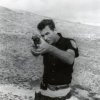leadcounsel
member
So, rifles and handguns have been around for what, a few hundred years going back to their infancy... "modern" weaponry being around for say a century. Why then, has it taken until say the last couple decades for the widespread training in weapon handling techniques such as weaver stance with two hands on pistol, holding rifles at the low ready, etc.?
Watching old videos of police and Soldier training, handguns were fired one handed like in a fencing stance (with the off hand on the back hip, shooter standing tall with legs locked), and rifles carried at the hip/waist...
"Modern" training and shooting simply seems that these would have been immediately natural movements with these firearms (two handed stance, low ready with rifles, etc...)... so any thoughts on why it took a century or more to get where we are?
Watching old videos of police and Soldier training, handguns were fired one handed like in a fencing stance (with the off hand on the back hip, shooter standing tall with legs locked), and rifles carried at the hip/waist...
"Modern" training and shooting simply seems that these would have been immediately natural movements with these firearms (two handed stance, low ready with rifles, etc...)... so any thoughts on why it took a century or more to get where we are?




